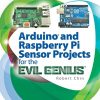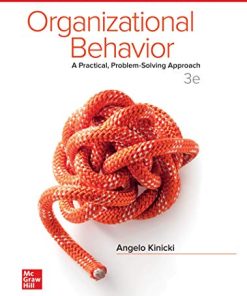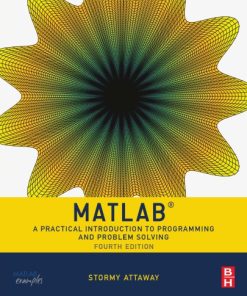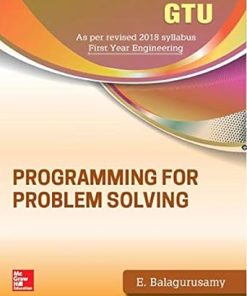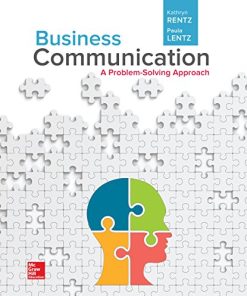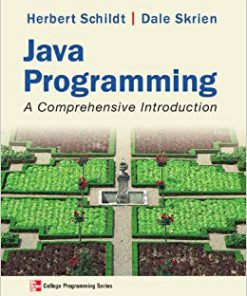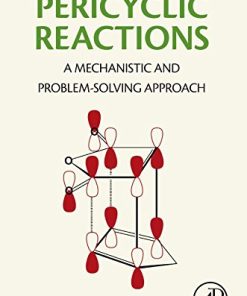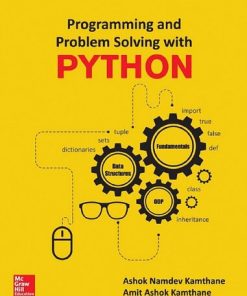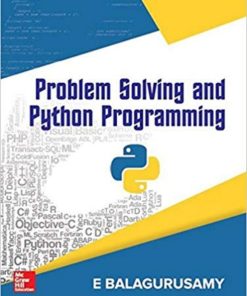(Ebook PDF) Introduction to Programming with Java A Problem Solving Approach 3rd Edition by John Dean,Ray Dean 1260047806 9781260047806 full chapters
$50.00 Original price was: $50.00.$25.00Current price is: $25.00.
Introduction to Programming with Java: A Problem Solving Approach 3rd Edition by John A. Dean,Ray Dean – Ebook PDF Instant Download/DeliveryISBN: 1260047806, 9781260047806
Full download Introduction to Programming with Java: A Problem Solving Approach 3rd Edition after payment
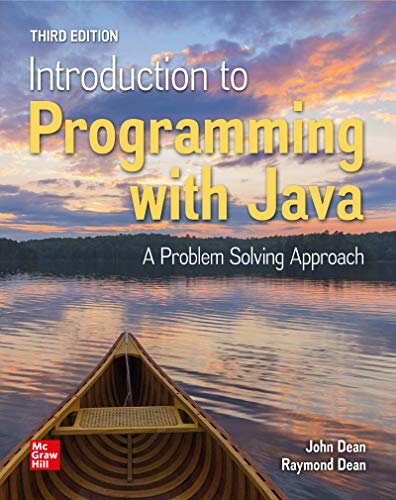
Product details:
ISBN-10 : 1260047806
ISBN-13 : 9781260047806
Author: John A. Dean , Ray Dean
Introduction to Programming with Java: A Problem Solving Approach
Introduction to Programming with Java: A Problem Solving Approach 3rd Table of contents:
Chapter 1
Introduction to Computers and Programming 1
1.1 Introduction
1.2 Hardware Terminology
1.3 Program Development
1.4 Source Code
1.5 Compiling Source Code into Object Code
1.6 Portability
1.7 Emergence of Java
1.8 Computer Ethics
1.9 First Program—Hello World
1.10 GUI Track: Hello World (Optional)
Chapter 2
Algorithms and Design
2.1 Introduction
2.2 Output
2.3 Variables
2.4 Operators and Assignment Statements
2.5 Input
2.6 Flow of Control and Flowcharts
2.7 if Statements
2.8 Loops
2.9 Loop Termination Techniques
2.10 Nested Looping
2.11 Tracing
2.12 Problem Solving: Other Pseudocode Formats and an Asset Management Example
Chapter 3
Java Basics
3.1 Introduction
3.2 “I Have a Dream” Program
3.3 Comments and Readability
3.4 The Class Heading
3.5 The main Method’s Heading
3.6 Braces
3.7 System.out.println
3.8 Compilation and Execution
3.9 Identifiers
3.10 Variables
3.11 Assignment Statements
3.12 Initialization Statements
3.13 Numeric Data Types—int, long, float, double
3.14 Constants
3.15 Arithmetic Operators
3.16 Expression Evaluation and Operator Precedence
3.17 More Operators: Increment, Decrement, and Compound Assignment
3.18 Tracing
3.19 Type Casting
3.20 char Type and Escape Sequences
3.21 Primitive Variables Versus Reference Variables
3.22 Strings
3.23 Input—the Scanner Class
3.24 Simple File Input for Repetitive Testing During Program Development
3.25 GUI Track: Input and Output with Dialog Boxes (Optional)
Chapter 4
Control Statements
4.1 Introduction
4.2 Conditions and Boolean Values
4.3 if Statements
4.4 && Logical Operator
4.5 | | Logical Operator
4.6 ! Logical Operator
4.7 Switching Constructs
4.8 while Loop
4.9 do Loop
4.10 for Loop
4.11 Solving the Problem of Which Loop to Use
4.12 Nested Loops
4.13 boolean Variables
4.14 Input Validation
4.15 Problem Solving with Boolean Logic (Optional)
Chapter 5
Using Prebuilt Methods
5.1 Introduction
5.2 The API Library
5.3 Math Class
5.4 Wrapper Classes for Primitive Types
5.5 Character Class
5.6 String Methods
5.7 Formatted Output with the printf> Method
5.8 Problem Solving with Random Numbers (Optional)
5.9 GUI Track: Covering an Image with a Tinted Pane (Optional)
Interlude
Multiple-Method Programs in a Non-Object-Oriented Environment
GUI Track: Multiple-Method Program That Uses StackPane and Group to Display Images, Rectangles, Lines, an Oval, and Text (Optional)
Chapter 6
Object-Oriented Programming
6.1 Introduction
6.2 Object-Oriented Programming Overview
6.3 First OOP Class
6.4 Driver Class
6.5 Calling Object, this Reference
6.6 Instance Variables
6.7 Tracing an OOP Program
6.8 UML Class Diagrams
6.9 Local Variables
6.10 The return Statement
6.11 Argument Passing
6.12 Specialized Methods—Accessors, Mutators, and Boolean Methods
6.13 Problem Solving with Simulation (Optional)
Chapter 7
Object-Oriented Programming— Additional Details
7.1 Introduction
7.2 Object Creation—A Detailed Analysis
7.3 Assigning a Reference
7.4 Testing Objects for Equality
7.5 Passing References as Arguments
7.6 Method-Call Chaining
7.7 Overloaded Methods
7.8 Constructors
7.9 Overloaded Constructors
7.10 Static Variables
7.11 Static Methods
7.12 Named Constants
7.13 Problem Solving with Multiple Driven Classes
Chapter 8
Software Engineering
8.1 Introduction
8.2 Coding-Style Conventions
8.3 Documentation for Outsiders
8.4 Helper Methods
8.5 Encapsulation (with Instance Variables and Local Variables)
8.6 Recognizing the User’s Point of View
8.7 Design Philosophy
8.8 Top-Down Design
8.9 Bottom-Up Design
8.10 Case-Based Design
8.11 Iterative Enhancement
8.12 Merging the Driver Method into the Driven Class
8.13 Accessing Instance Variables Without Using this
8.14 Writing Your Own Utility Class
8.15 Problem Solving with the API Calendar Class (Optional)
8.16 GUI Track: Problem Solving with CRC Cards (Optional)
Chapter 9
Arrays
9.1 Introduction
9.2 Array Basics
9.3 Array Declaration and Creation
9.4 Array length Property and Partially Filled Arrays
9.5 Copying an Array
9.6 Problem Solving with Array Case Studies
9.7 Searching an Array
9.8 Sorting an Array
9.9 Two-Dimensional Arrays
9.10 Arrays of Objects
9.11 For-Each Loops
Chapter 10
ArrayLists and an Introduction to the Java Collections Framework
10.1 Introduction
10.2 The ArrayList Class
10.3 Storing Primitives in an ArrayList
10.4 ArrayList Example Using Anonymous Objects and the For-Each Loop
10.5 ArrayLists Versus Standard Arrays
10.6 The LinkedList Class
10.7 The List Interface
10.8 Problem Solving: How to Compare Method Execution Times
10.9 Queues, Stacks, and the ArrayDeque Class
10.10 Overview of the Java Collections Framework
10.11 Collections Example—Information Flow in a Network of Friends
10.12 GUI Track: Second Iteration of Problem Solving with CRC Cards (Optional)
Chapter 11
Recursion
11.1 Introduction
11.2 Guidelines for Writing a Recursive Method
11.3 A Recursive Factorial Method
11.4 Comparison of Recursive and Iterative Solutions
11.5 Recursive Method Evaluation Practice
11.6 Binary Search
11.7 Merge Sort
11.8 Towers of Hanoi
11.9 Problem Solving with Performance Analysis
11.10 GUI Track: Drawing Trees with a Fractal Algorithm (Optional)
Chapter 12
Type Details and Alternative Coding Mechanisms
12.1 Introduction
12.2 Integer Types and Floating-Point Types
12.3 char Type and the ASCII Character Set
12.4 Type Conversions
12.5 Prefix/Postfix Modes for Increment/ Decrement Operators
12.6 Embedded Assignments
12.7 Conditional Operator Expressions
12.8 Expression Evaluation Review
12.9 Short-Circuit Evaluation
12.10 Empty Statement
12.11 Using break to Exit from a Loop
12.12 for Loop Header Details
12.13 Enumerated Types
12.14 forEach Method, Lambda Expressions, Method References, and Streams
12.15 Hexadecimal, Octal, and Binary Numbers
12.16 GUI Track: Unicode (Optional)
12.17 Introduction to GridWorld Case Study (Optional)
Chapter 13
Aggregation, Composition, and Inheritance
13.1 Introduction
13.2 Composition and Aggregation
13.3 Inheritance Overview
13.4 Implementation of a Person/Employee/FullTime Hierarchy
13.5 Constructors in a Subclass
13.6 Method Overriding
13.7 Using the Person/Employee/FullTime Hierarchy
13.8 The final Access Modifier
13.9 Using Inheritance with Aggregation and Composition
13.10 Design Practice with Card Game Example
13.11 GridWorld Case Study Extensions (Optional)
13.12 Problem Solving with Association Classes (Optional)
Chapter 14
Inheritance and Polymorphism
14.1 Introduction
14.2 The Object Class and Automatic Type Promotion
14.3 The equals Method
14.4 The toString Method
14.5 Polymorphism and Dynamic Binding
14.6 Assignments When the Two Sides’ Classes Are Different
14.7 Polymorphism with Arrays
14.8 abstract Methods and Classes
14.9 Interfaces
14.10 The protected Access Modifier
14.11 GUI Track: Three-Dimensional Graphics (Optional)
Chapter 15
Exception Handling
15.1 Introduction
15.2 Overview of Exceptions and Exception Messages
15.3 Using try and catch Blocks to Handle “Dangerous” Method Calls
15.4 Line Plot Example
15.5 try Block Details
15.6 Two Categories of Exceptions—Checked and Unchecked
15.7 Unchecked Exceptions
15.8 Checked Exceptions
15.9 Generic catch Block with Exception Class
15.10 Multiple catch Blocks and Multiple Exceptions per Block
15.11 Understanding Exception Messages
15.12 Using a throws Clause to Postpone the catch
15.13 Automatic Cleanup Using Try-With-Resources
15.14 GUI Track: Line Plot Example Revisited (Optional)
Chapter 16
Files, Buffers, Channels, and Paths
16.1 Introduction
16.2 Simple Text-File Example: HTML File Generator
16.3 A Website Reader
16.4 Object File I/O
16.5 Character Sets and File-Access Options
16.6 Buffered Text File I/O
16.7 Primitive Buffers with Random Access
16.8 Channel I/O and Memory-Mapped Files
16.9 Path, Whole-File, and Directory Operations
16.10 Walking a Directory Tree
16.11 GUI Track: Final Iteration of Problem Solving with CRC Cards (Optional)
Chapter 17
GUI Programming Basics
17.1 Introduction
17.2 SimpleWindow Program
17.3 Stage and Scene
17.4 JavaFX Components
17.5 Label Control
17.6 TextField Control
17.7 Greeting Program
17.8 Event Handling
17.9 Property Binding
17.10 JavaFX CSS
17.11 Scene Graph Inheritance
17.12 Style Sheets and Cascading
17.13 Button Control and FactorialButton Program
17.14 Distinguishing Between Multiple Events
17.15 Colors
17.16 ColorChooser Program
Chapter 18
GUI Programming—Layout Panes
18.1 Introduction
18.2 Layout Panes
18.3 FlowPane and GridPane—Competing Layout Philosophies
18.4 VBox Program with Two Stages and an Image File
18.5 BorderPane
18.6 TilePane and TextFlow Containers
18.7 TicTacToe Program
18.8 Embedded Panes, HBox, and MathCalculator Program
18.9 Plain Pane Container and Component Positioning
Chapter 19
GUI Programming—Additional GUI Components, Additional Event Handlers, Animation
19.1 Introduction
19.2 User Interface Design
19.3 TextArea Control
19.4 CheckBox and RadioButton Controls
19.5 ComboBox Control
19.6 Job Application Program
19.7 ScrollPane and Menu Classes
19.8 Images and Mouse Events
19.9 Lunar Eclipse Program with Circle, RadialGradient, and Slider
19.10 Animation
People also search for Introduction to Programming with Java: A Problem Solving Approach 3rd:
introduction to programming with javascript
introduction to programming with java pdf
introduction to programming with java book
an introduction to object oriented programming with java
introduction to programming with python and java specialization
Tags:
Introduction,Programming,Java,Problem Solving,Approach,John Dean,Ray Dean
You may also like…
Business & Economics - Management & Leadership
Organizational Behavior: A Practical, Problem-Solving Approach 3rd Edition Angelo Kinicki
Computers - Programming
Python Programming: Using Problem Solving Approach 1st Edition Reema Thareja
Mathematics Computers - Programming
MATLAB: A Practical Introduction to Programming and Problem Solving 4th Edition Stormy Attaway
Uncategorized
Chemistry - Organic Chemistry
Pericyclic Reactions: A Mechanistic and Problem-Solving Approach 1st Edition
Computers - Programming


